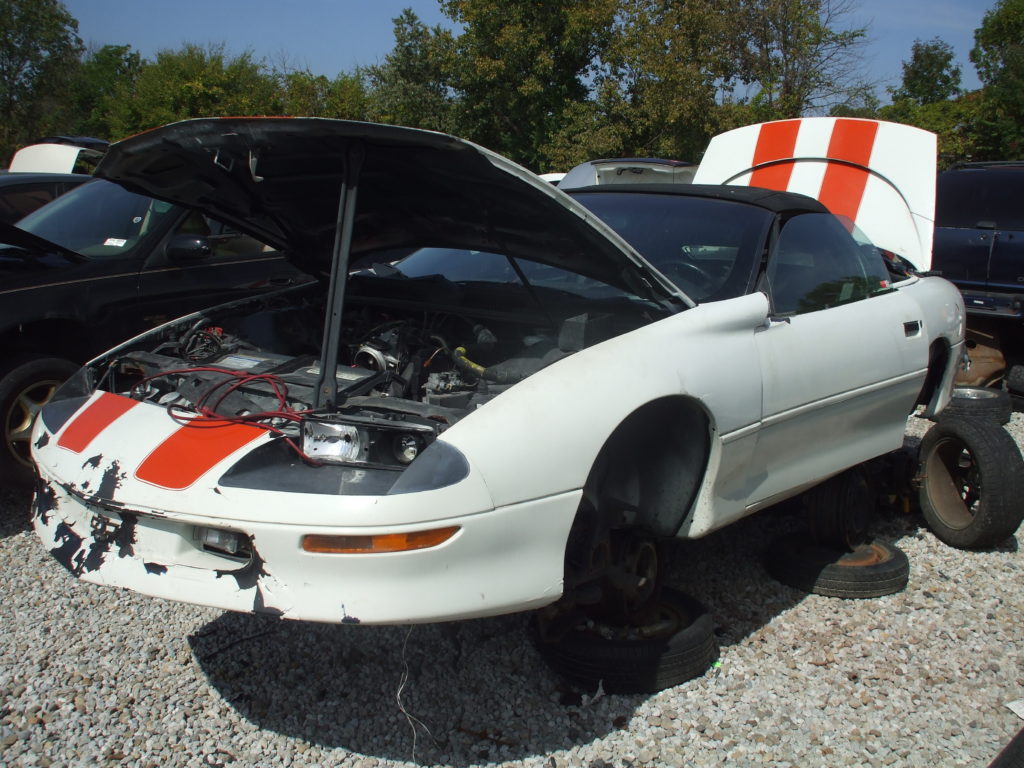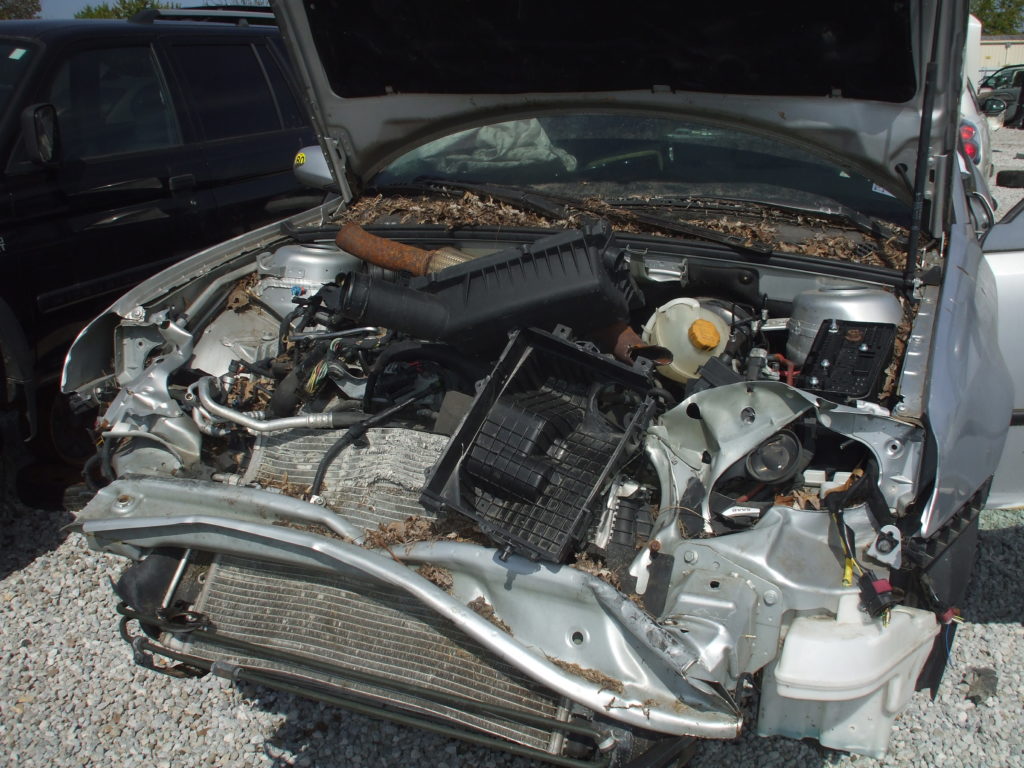Going to a junkyard is gearhead rite-of-passage.
Whether it’s to save money, source rare parts, or repurpose components for a custom build, every experienced wrencher has made at least one trip to a scrapyard.
***
Story Summary Overview:
- Sourcing parts from a junkyard can be a smart, affordable way to repair your vehicle
- It can also help you find parts that are obsolete and no longer available for sale new
- Getting used parts from a junkyard isn’t like buying parts off a shelf
- There’s a significant bit of DIY involved that you need to prepare for
- This article offers helpful tips to ensure your junkyard trip is a successful one
***
A junkyard is essentially a big field filled with wrecked vehicles that you pay money to remove parts from. Everything on the vehicle is up for grabs—including complete engines. (Looking for an LS motor? Check out Part 1 and Part 2 of our LS Engine Spotter’s Guides to learn how to more easily find one.)
Junkyard shopping is often a great way to find used parts on the cheap or grab components that are no longer available, but it’s a totally different experience from buying something at a swap meet or parts counter.
We asked OnAllCylinders’ own scrapyard sages, Rick Eash and Jason Liss, if they had any tips to bestow.
Here’s what they came up with.
13 Tips for Sourcing Junkyard Car and Truck Parts

1. Plan your Pull
Figure out what part you need, plus any related components. Make sure a junkyard part will work for what you need. As with buying anything used, a junkyard part (like an electrical component or a structural piece) carries an inherent risk of pre-existing problems.
2. Take Pictures
Got a digital camera or a smartphone? Use it to document the job, both before in your own vehicle and again at the yard. An accurate picture of the part and its surroundings will ensure you’re making the right pull.
3. Outfit Your Toolbox
Tools will rarely be available at the yard, so you must use your own. Bring as few tools as possible, but make sure you have what you need. Remove the bad part from your vehicle first and make a note of what tools you used. Did removing the part require special sockets, like Torx or Allen heads? Pay attention to how the part fits, and if there are any impediments to removal—you may need a cutting tool to get access to the component on a scrapped vehicle.
4. Outfit Yourself
On hot days, bring a hat and plenty of water, for cold days bring gloves and an ice scraper. Sturdy boots are a must, and if you’ll be lying on the ground, then a padded mat is your best friend. Coveralls can keep muck and grease off your clothes. Maybe pack sunscreen, bug spray, or wasp killer? (Ask us how we know!)
5. Wear Mechanics Gloves
Unless you’re pulling something simple like a shift knob, gloves are a no-brainer.
6. Bring Eye Protection
Junkyard cars are often filled with rust, goo, and other unidentifiable gunk. Protect your peepers from fluids and debris with a set of safety glasses—especially if you’ll be lying on your back.

7. Scout First
If you’ve got to bring a lot of gear to your pull, leave it in your vehicle and check out the scrapped car first. That’ll save you from lugging around unnecessary tools and supplies.
8. Bring Cleaning Supplies
Remember, this is a junkyard. There’s a good chance you’ll be cleaning muck off of bolt heads and wiping oil away from your part. Brushes and shop towels are pretty handy.
9. Wire Cutters Cut More Than Wire
A lot of vehicles have special plastic fasteners that are a headache to remove. A set of diagonal cutting pliers (AKA wire cutters, side cutters, or dikes) can cure that.
10. Bring Impacts and Breakers
This tip is job-specific, but if you’re pulling a large chassis or engine component, a battery-powered impact wrench or breaker bar is worth its weight in gold.
11. Grab What’s Important
A big advantage of a junkyard is that you can pull off all the extra brackets, hardware, fasteners, and wiring you’ll need to install the part. Take a “big-picture” look at the part—and make sure you pull as much as you need.
12. Understand Cores/Returns
If you’re lucky, your junkyard will allow returns—but don’t bet on it. Make sure you’re pulling the right part the first time. Also, many yards now have core charges on certain parts. Call ahead or check online first—bringing your old core with you the first time will save a trip.
13. Bring Cash
Small bills especially. A lot of yards don’t take credit cards, and making an attendant break a $100 bill for a $4 part is a dimwit move.
…
A final bonus tip? A shower afterward.
If you’ve got any hints of your own, let us know in the comments!


Also have Wasp/hornet & mosquito spray. No matter how hot it is wear protective clothing like long sleeved shirt, long pants,boots
I brought my 10 year old grandson with me as I toured our local yard. He was mesmerized and very impressed… reminded me of when my dad brought me to a yard back in the 1960s. TRULY a rite of passage for future knucklebusters.
This particular problem was mentioned in the story and in a comment but it’s especially bad in southern states during hot weather. MOSQUITOES ! Salvage yards are natural breeding areas due to so many sources of standing water that collects from rain. So bring along some insect repellent because standing outside the salvage yard you won’t see a single mosquito but after getting inside their habitat, the battle begins.
Something else to consider is snakes. Rattlesnakes in particular here in Georgia during the summer. Especially in poorly maintained junkyards that are overgrown with bushes and weeds. Wearing heavy boots that extend well above the ankle can help prevent a deep puncture from a bite. They are uncomfortable in the heat but considering the discomfort caused by a venomous predator, it’s not so bad. Happy hunting !!!
To add on to the tip about what tools to bring when I am removing whatever part it is I am going to source at the junkyard.
Whatever tools I used when removing the part automatically get rounded and put in my tool bag to take with me to the yard so I can duplicate the same process of removal, with the same exact tools I used at my house. Also bring a can of rust penetrate just in case. Its not very pleasant when a bolt snaps off at the wreaking yard and your up s*%ts creek
…..been there.
Also, remember that mosquito repellant will repell more than just flying insects. There are ticks and chiggers and other creepy crawlys that won’t crawl on you if your covered in a quality bug repellant. Off Deep Woods is all I trust. My employer used to take jobs spraying auto recycling yards. It only took one time for me to appreciate the value of covering my legs with the stuff, Of course I wore the recommended PPE but that protective equipment was meant to protect the technician from the chemical he/she was applying, not a tiny, thirsty crab-looing thing that wants to make your nether regions it’s mining site for blood and personal expansion. Even in cowboy boots and long pants you still want to cover your legs.
[…] The aftermarket is strong, crate engines are available, and used motors are often cheaply sourced through junkyards. […]
[…] The aftermarket is strong, crate engines are available, and used motors are often cheaply sourced through junkyards. […]
[…] The aftermarket is strong, crate engines are available, and used motors are often cheaply sourced through junkyards. […]
[…] The aftermarket is strong, crate engines are available, and used motors are often cheaply sourced through junkyards. […]
[…] There are several engines within the LS family. So if you’re going to swap or modify an LS, the first thing you’ll need to know is which particular engine you have or want, and how to find it (should you choose to not go with one of the many LS crate engines available). That means understanding the various technical nuances of each LS RPO code, so you know which new parts to buy, or what old parts to salvage on your next trip to the junkyard. […]
[…] are 13 tips that’ll help you get the best deals and […]
[…] Junkyard Jewels: 13 Tips for Scrapyard Parts Scrounging Uncategorized […]
[…] The aftermarket is strong, crate engines are available, and used motors are often cheaply sourced through junkyards. […]
[…] The aftermarket is strong, crate engines are available, and used motors are often cheaply sourced through junkyards. […]
[…] The aftermarket is strong, crate engines are available, and used motors are often cheaply sourced through junkyards. […]
[…] The aftermarket is strong, crate engines are available, and used motors are often cheaply sourced through junkyards. […]
[…] The aftermarket is strong, crate engines are available, and used motors are often cheaply sourced through junkyards. […]
looking for a ls6 small block engine, with all accessories that come with it, with a reasonable price, please email me thomas.darrell56@gmail.com
Hi I’m looking for a LQ4 engine if anyone can help me find one please email me at spotlessmitch@gmail.com
Thank you
[…] And the more I thought about it, the more a mock-up motor and transmission started to make sense. Sure I could use a junk 454 block, but then I have to drag out my cherry picker to fit the thing in my engine compartment. All of a sudden, it becomes a big job. Plus there’d be no way to know if something like a Jerico would fit (you can’t find those easily in junkyards). […]
[…] The aftermarket is strong, crate engines are available, and used motors are often cheaply sourced through junkyards. […]
[…] By https://www.onallcylinders.com/2017/10/06/junkyard-jewels-13-tips-for-scrapyard-parts-scrounging/ […]